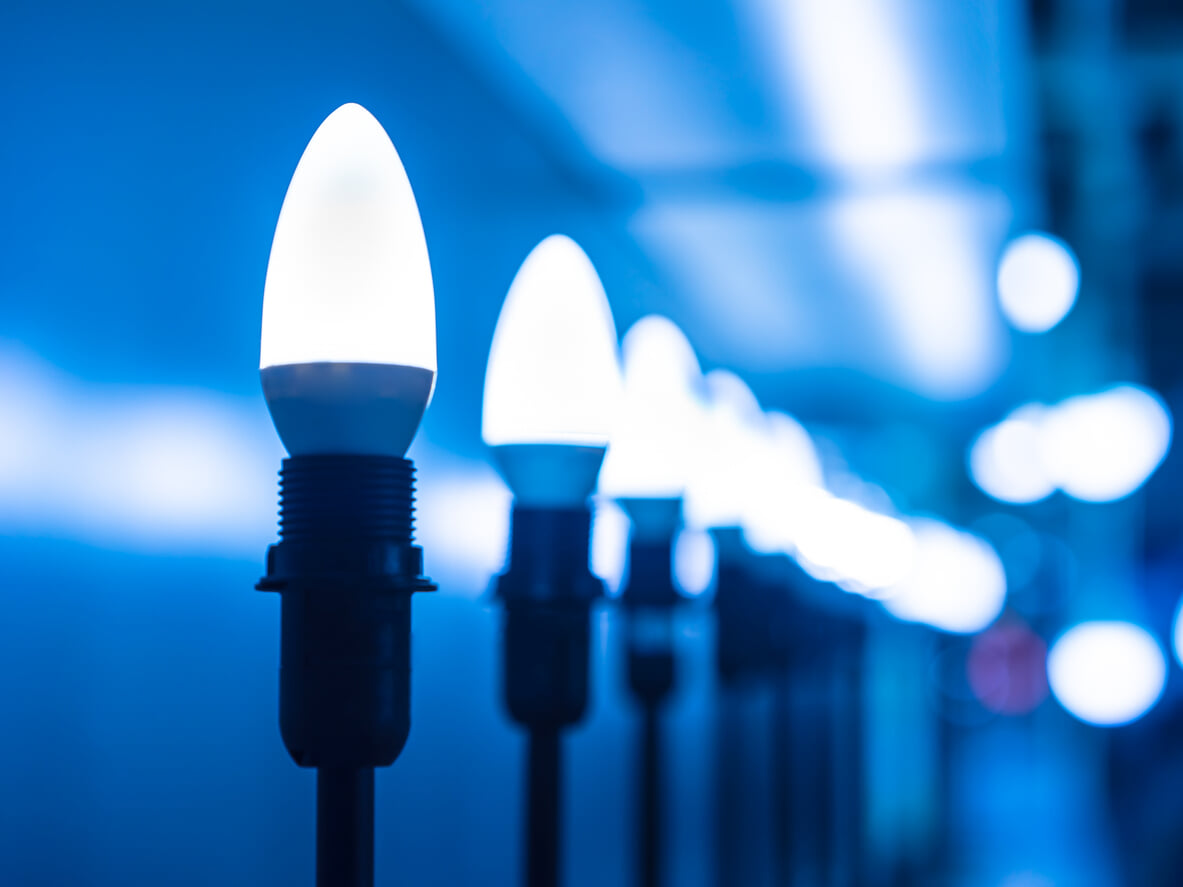Lighting accounts for about 12% of global electricity consumption. JAGGAER customer Signify, best known for the Philips brand, argues that lighting is “part of the problem” but therefore also “part of the solution” for decarbonization. Lighting’s share of electricity use has been declining for a decade thanks to LEDs and better controls, and the downward trend should continue with further efficacy gains and saturation of LED sales. Source efficiencies have improved by an order of magnitude (from around 10–15 lumens per Watt (lm/W) for incandescents to >150–200 lm/W for modern LEDs), which translates to 80–90% less electricity per lumen at the source (system-level savings vary). As a result, total electricity (TWh) for lighting has likely plateaued or fallen in many regions even while service demand (lumens delivered) keeps rising.
Signify’s own scenario suggests that lighting’s share of global electricity consumption could drop to around 8% by 2030 even as light points rise. As energy consumption falls, so do carbon emissions. The United Nations Environment Programme (UNEP), the International Energy Agency (IEA) and Signify itself have all worked on quantifying this impact. So, let’s consider their findings. They differ slightly but are broadly in alignment.
According to UNEP’s en.lighten initiative and IEA estimates, lighting currently accounts for roughly 4–5% of global CO₂ emissions, That’s derived from what UNEP estimates to be a 12–15% share of global electricity consumption, assuming an average global grid intensity of ~400 g CO₂/kWh. In absolute terms, this equates to around 1.5 – 2 gigatonnes of CO₂ per year. To put this in perspective, it’s roughly the same as the total annual emissions of Japan and Germany combined. About two-thirds of the total comes from the residential and commercial building sectors, with the rest from industrial and outdoor lighting.
Transitioning fully to LED and connected lighting (with sensors, daylight harvesting, smart controls) thus represents one of the fastest, cheapest decarbonization levers in the built environment. Upgrading all existing lighting to the best-available LED systems could cut global lighting electricity use by 60–70% compared with the pre-LED baseline. This equates to a potential 1 gigatonne of CO₂ avoided per year globally, a figure cited by Signify, the IEA, and UNEP’s Global Lighting Challenge. Because lighting upgrades are relatively inexpensive and rapidly deployable, they offer one of the highest returns on investment in climate action. The technology is mature, with no behavioral or infrastructure barriers beyond policy and financing.
According to the IEA Net Zero by 2050 scenario and IEA Energy Efficiency 2023, by the end of this year, close to 100% of global lighting sales should be high-efficiency LED, and by 2030, the average system efficacy (including drivers, optics, and controls) needs to improve a further 25–30%. The result would be a fall in lighting-related emissions by around 50% by 2030 compared with 2020 levels, even though total light output (lumens) will continue to grow sharply.
Signify frames this as “lighting can deliver 20% of the energy savings needed for Net Zero”, because of its large baseline and low abatement cost.
However, this can only take us so far. After global LED saturation, remaining emissions will increasingly depend on grid decarbonization rather than further lighting efficiency. As the electricity mix shifts to renewables, the marginal CO₂ benefit of lighting improvements decreases, but lighting still remains vital in the near term (2020s) because it front-loads early reductions.
The challenge ahead
Consequently, the challenge ahead for Signify (and the rest of the industry) will be to reduce its carbon footprint in the extended supply chain. Procurement moves center-stage. Whereas historically, 80–90 % of a luminaire’s life-cycle emissions came from electricity used during operation, with only 10–20 % from materials, manufacturing, and logistics, in the LED era the balance flips: 50% or more of life-cycle emissions will soon come from Scope 3 sources (materials, components, transport, and end-of-life). Consequently, even if lighting operation becomes near-zero-carbon, the lighting industry must tackle its upstream footprint to achieve true net zero.
Signify’s short-term target, to achieve a more than 50% reduction in carbon emissions across Scopes 1, 2 and 3 by 2030 (against the baseline of 2019) has already been more than met (the company is currently at more than 60%). The long-term aim, of achieving a 90% reduction across the full value chain by 2040, is being pursued through a range of initiatives, including:
- Circular-economy design: modular, repairable luminaires and reuse of components.
- Low-carbon materials: recycled aluminum, bioplastics, and low-carbon steel in fittings.
- Supplier engagement: requiring top suppliers to set science-based targets (SBTi) and disclose emissions through CDP carbon disclosure.
- Renewable logistics: switching to green shipping and warehousing.
- Product-level Life Cycle Assessment (LCA) data and EPD labelling (Environmental Product Declarations), which enable reductions by providing quantified transparency.
Carbon-intelligent sourcing
These actions mirror a wider trend across the entire electrical-equipment industry: shifting climate focus from direct energy use to supply-chain decarbonization and circularity. “Where we really struggle to move the dial is in the supply chain,” says Nithya Suri Narayan, Supplier Sustainability & Audits Manager at Signify.
Supplier intelligence, and effective action on that intelligence, provides the biggest lever to tackle this challenge, and to this end Signify has worked with JAGGAER and its partner, carbmee. The way forward involved first, a methodology shift from estimation-based reporting to supplier-specific emissions management based on carbmee data, which provides much greater granularity and accuracy; second, supplier engagement: collaborative partnerships to co-create and drive reduction scenarios; and third, integration, i.e., linking sourcing decisions directly to carbon reduction outcomes. Arnold Chatelain, Transformation Program Manager at Signify, “The three-way partnership involves us using the data we get from carbmee in our sourcing events conducted with JAGGAER.”
The result is carbon-intelligent sourcing decisions, with a focus on the emissions hotspots (around 80% of emissions in the supply chain occur in 20% of supply categories). Carbon-intelligent sourcing decisions not only ensure compliance with sustainability regulations but also provide leverage in negotiations with suppliers. By requiring suppliers to compete on both price and decarbonization (and other sustainability criteria), companies like Signify will not only accelerate the drive towards net zero but also succeed in containing or reducing costs and fostering innovation.
On-Demand Webinar: The Hidden Power of Carbon in Procurement
Carbmee’s Environmental Intelligence System (EIS™) provides a single source of truth for CO2-related data, bridging the gap between deep LCA analysis and practical supply chain management to enable carbon reduction strategies and transparency for regulatory compliance. It integrates supplier-specific emissions data into the LCA, moving beyond generic industry-standard emission factors.
Discover how leading companies are cutting both emissions and costs by embedding carbon intelligence into their procurement strategies. S
ee how Signify and other innovators are driving measurable impact through data-driven decisions, digital tools, and smarter sourcing practices.
Learn more and watch the full on-demand session here.
eBook: Carbon Management – The Hidden Source of Procurement Savings
Explore how leading organizations turn carbon visibility into measurable impact — reducing costs, driving sustainability, and gaining a competitive edge in procurement.
Learn more and download the full eBook here.
About Signify
Signify is the world’s number one in connected, LED and conventional lighting for professionals, consumers and the Internet of Things. The company’s energy-efficient lighting products, systems and services enable its customers to enjoy a superior quality of light, and make people’s lives safer and more comfortable, businesses more productive and cities more livable. With 2024 sales of EUR 6.1 billion, approximately 29,000 employees and a presence in over 70 countries, Signify is “unlocking the extraordinary potential of light for brighter lives and a better world.”
Read next: Signify Automates, Standardizes and Innovates in Procurement




